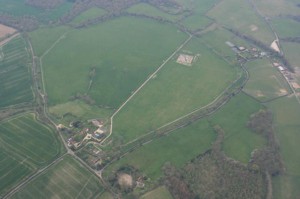Calleva: the Last Romano-British City October 14, 2010
Author: Beach Combing | in : Ancient, Medieval , trackback Beachcombing finishes, today, his rapid tour around bizarre or curious near-London and London sites: a work he has undertaken partly for Canadian History Student and partly out of nostalgia – he is in Italy at the moment. And what better place to end than Calleva Atrebatorum, the Woody Place of the Atrebates Tribe, way out past ugly Reading?
Beachcombing finishes, today, his rapid tour around bizarre or curious near-London and London sites: a work he has undertaken partly for Canadian History Student and partly out of nostalgia – he is in Italy at the moment. And what better place to end than Calleva Atrebatorum, the Woody Place of the Atrebates Tribe, way out past ugly Reading?
Calleva – aka Silchester – is the British Pompeii. Admittedly there is no volcano in the rather flat British countryside here: but this is the best preserved Roman city in the UK. The key to its preservation was Calleva’s afterlife. Unlike other Roman cities, e.g. London, Calleva was not built on again in the early Middle Ages. Instead, nearby Basing and Reading took over, leaving the shell of the now abandoned Roman city surprisingly intact.
The result is that you can today drive to Calleva – or in the case of Beachcombing be driven – and walk around its ‘walls’, essentially earth covered banks. You can even go to the Coliseum, or what is left of it, and marvel at its hollowed out rib-cage, now grown over with English oaks, oaks that were not even acorns in their mothers’ eyes when this place was last open to a paying public.
It is perhaps in the coliseum that you come closest to the Callevans of Roman times. So many men, women and children slipping like sand through the fingers of time… Beachcombing also gets a kick walking on the walls and staring inwards at the dull fields, where the lines of the insulae are just visible, and imagining the city at night: the whispering, the love-making, the graffitists, the watchmen…
However, make no mistake, for Beachcombing the most interesting part of Calleva’s history is its end.
In the early fifth century the lights go out in Britain and Roman-British cities rapidly empty as the Empire pulls out and the barbarians pour in. Calleva, however, was likely an exception to this rule with Callevans holding out against the invading Anglo-Saxons, the early English, for perhaps as much as a century.
How did the Callevans do it? Mercenaries perhaps. One of the most exciting pieces of evidence from the late city is a small inscription with ogham (an Irish writing system) suggesting that Gael warriors may have been brought in by the burghers of Calleva. Think the Seven Samurai with tattooed Fenians from the bad lands of antique Leinster, instead of Kambei and Kyuzo and their steel swords.
It is certainly an exciting thought. A lone Roman-British city holding out – Asterix-and-Obelix-style – against the new age. Children going to school to learn Virgil and being told not to wander too far from the walls. Romano-British men and women walking towards the coliseum complaining about the lack of garum and olive oil, no longer shipped from the Mediterranean. And Silchester’s Romano-British bishop entering reluctantly into negotiations with the Germanic savages ‘settling’ the Thames valley who were already indulging in the occasional bout of human sacrifice.
But can we prove that Calleva survived in this fashion? It is striking that much of the evidence for late Roman Calleva is an absence of evidence and a handful of difficult or impossible to date material from ‘sometime’ in the fifth century. Even the precious ogham stone has been written off by some as a fake – the horror!
The truth is that the twilight of Calleva is uncertain as it is strange, a glimmer of the evening sun on a metal sun dial. Perhaps this makes any visit all the more alluring…
Any more on Calleva or unusual spots to visit in Britain then do please write to Beachcombing: drbeachcombing AT yahoo DOT com


